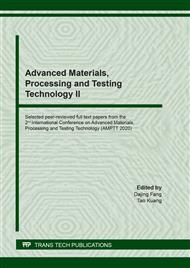p.20
p.27
p.32
p.40
p.46
p.53
p.59
p.65
p.73
Study on Fatigue Crack Growth of Laser Melting Deposited 12CrNi2 Alloy Steel Based on XFEM
Abstract:
Based on the Paris model of fatigue crack growth theory, the fatigue crack growth behaviour of Center Crack Tension (CCT) specimens of laser melting deposited 12CrNi2 alloy steel is studied by extended finite element method (XFEM). The crack growth rules and fatigue life are analyzed by experiment and finite element simulation. The experimental results are in good agreement with the finite element results, which verifies the accuracy of XFEM method to simulate the fatigue crack growth behaviour of laser melting deposited 12CrNi2 alloy steel components. Based on this, the effects of initial crack direction and load amplitude on fatigue crack growth behaviour are discussed. The results indicate that even if the initial crack direction is different, the crack will finally propagate in a direction perpendicular to the load. With the increase of the load amplitude, the fatigue life of the specimen with initial crack decreases exponentially.
Info:
Periodical:
Pages:
46-52
Citation:
Online since:
January 2021
Authors:
Keywords:
Price:
Сopyright:
© 2021 Trans Tech Publications Ltd. All Rights Reserved
Share:
Citation:


